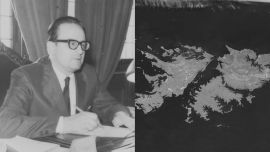The smells swirl through the air on the walk down Calle Perdriel, where through the low wrought-iron fence and greenery, the white stucco walls of the British Hospital peek out.
Taking up an entire city block in Barracas, the hospital boasts in longevity what it also claims in forward-thinking medical care and complex medicine. The Hospital Británico, as its known by most locals, is an ever-present feature of this Buenos Aires neighbourhood – this year it celebrates the 175th anniversary of its founding.
An institution nearly as old as Argentina itself, the British Hospital was founded in 1844 as a non-profit institution. It was the first health centre to be founded and created by a community of immigrants in Argentina, later to be accompanied by sister centres like the German, Italian, and French hospitals.
“There were about 20 hospitals. There was no medicine, throughout the country there was no sort of medical care, and so every community organised their own,” explained Director General Dr. Angel J. Yebara in an interview with the Times last year.
In one of the hospital’s conference rooms, a portrait of the Reverend Barton Lodge hangs on the wall alongside other black-and-white photos of nurses which came before. Matron Verónica Hortis de Smith, director of nursing, looks upon it fondly as she recalls the nursing school’s history.
“Reverend Barton Lodge was the first to take note of this and began by forming a commission. He said there needed to be a health centre to be able to take care of all of these English people who came to work on the railroads, in the meat-packing plants, in the field,” she explains.
In 1890, the British Hospital became home to Argentina's first nursing school, the Enfermería, which was founded by Isabel Eames, a graduate of The Nightingale Home and Training School for Nurses at London’s King’s College. Today the vast majority of both nurses and patients are Spanish-speakers, although many are bilingual.
Moved and influenced by the work of Florence Nightingale, of Crimean War fame, was doing at London’s St. Thomas Hospital, the first nurses who arrived in Buenos Aires came because the community needed doctors and nurses who spoke English, since their patients almost exclusively spoke English. At the time, the British community numbered almost 8,000 people.
BRITISH-ARGENTINE RELATIONS
Today, the hospital employs around 800 doctors, 500 nurses, 400 in ambulatory services, and they have a private health plan covering 40,000 lives in Argentina.
Ask any of its nearly 3,000 employees and they’ll speak passionately about the particular culture which finds a home within the hospital.
Noelia Zamparutti, Director of Communications, Fundraising and Institutional Relations, describes the hospital as a place where “British formality and this multi-dynamism that Argentines have” meet, and Director General Yebara echoes those sentiments.
“With 3,000 people it’s hard, but here everyone paints the ‘H’ and ‘B’ on their skin and everyone has a shared feeling of love for the hospital,” said Yebara. “People recognise the quality of the attention, and the humanity of it. We’re known for that. The walls here, they breathe tranquility, quality, affection.”
The hospital’s melding of Argentine and British cultures is physically represented by an encased metal rose, perched below the plaques listing the hospital directors since its inception. The rose, part of Argentine metalsmith Juan Carlos Pallarols’ “Dos rosas por la paz” series, is made from the shells of bullets collected in Malvinas/Falklands conflict. For each rose which is made and gifted or auctioned in Argentina, the same is done in the United Kingdom.
On the same wall as the rose, a sign above the main elevators showcases the names of all the hospital directors over the years.
“All the directors are descendents of the British community, and as of a few years ago is when it started to change,” remarks Zamparutti.
Despite its origins in the British-Argentine community, the hospital possesses no financial or governmental ties to the United Kingdom.
CHALLENGES AHEAD
As well as celebrations to mark the community's institution’s 175th anniversary, the hospital also has daunting challenges ahead.
For example, of the current 180,000 nurses in Argentina, 50,000 are set to retire in the next three years. At a press conference in 2016, President Mauricio Macri unveiled a four-year initiative to increase the number of nurses in the medical field began, saying his administration understood both the urgency and the scale of the situation.
“The country has a deficit of nurses in quantity and quality,” said Health Minister Jorge Lemus at the time, noting that “the doctor-nurse ratio today averages one to one and in some provinces five to one, exactly the opposite of what we need.”
Given the shortage of nurses not just in Argentina, but across the world, the British Hospital has given a high priority to economically supporting its school, which trains nurses free of charge up to highly recognised professional standards.
Indeed, training is a key part of the hospital’s role in the medical community in Argentina.
The British Hospital is a university hospital affiliated with the Faculty of Medicine at the University of Buenos Aires (UBA), and more recently the medical school of the Pontificia Universidad Católica in 2009. Currently, there are 350 students enrolled in the nursing school, along with the 200 residents and 55 fellows.
“Here we breathe academia. We breathe education. We have a high level of expectation,” said Yebara. “These three pillars – helping people, teaching, and research – make the quality of our medical care so extremely high.”
“With the legacy of taking care of people from the British community, our mission is one of community. Everything that we do comes back, and we try that it doesn’t only go back to our growth, but that it can be seen in our community,” Ralph Kirby, the British Hospital’s president from 2013 to 2018, told the Times.
“To survive 175 years is almost impossible. It’s very rare,” says Kirby.
“The economic ups and down in Argentina have been dramatic, and despite it all, the hospital never quit.”
A page out of the history books
The British Hospital seems to have been in Perdriel forever but in fact its Barracas presence dates back to 1885 while the current building was inaugurated in 1940, following massive pre-war fundraising by the British community. The foundation stone for major extensions was laid by Prince Charles in 1999. This was one of half-a-dozen royal visits since the celebrated trip of the later Edward VIII as Prince of Wales in 1925 (the Duke of Edinburgh has been in Perdriel twice) and the institution has been under the patronage of Queen Elizabeth II since her coronation year of 1953.
Until about a century ago almost all physicians and surgeons were brought out from Britain with a few local recruits from the British community but everybody was English-speaking. It took a century of existence before the Hospital started accepting doctors with degrees from Argentine universities.
Dr John Emery (a beacon of the recent past with half a century of service to the Hospital, ending in 2014) has compiled a long list of pioneering firsts at the British Hospital as from the first use of anaesthesia (ether) in surgery in this country by Dr John Mackenna in 1847 and including Argentina’s first bone marrow transplant in 1980.0
The Hospital has had an academic dimension since 1994 when it offered training for students at UBA Buenos Aires University ‘s Medical Faculty while in 2010 the Catholic University (UCA) chose the institution for the clinical and surgical training of the students at its recently inaugurated medical school.
The Nursing School goes back much further, of course, to the 19th century with remarkable continuity – only 11 matrons in almost 130 years, including three decades for Doreen Dover (1971-2000). Verónica Hortis de Smith has been in charge since 2004. Students undergo three years of training with good expectations of joining the staff after their graduation. Last year, a record 60 nurses graduated with a current 324 students.
The British Hospital has modernised considerably in this century thanks to extremely vigorous fundraising. An entirely revamped Children’s Ward (along with a modernised Paediatric Intensive Care Unit) and a state-of-the-art Cancer Centre are among the main beneficiaries although not the only ones. Total staff is in the 2,500- 3,000 range with just over 1,700 full-time employees, around 600 doctors on a fee payment basis and various ancillary workers.


























Comments